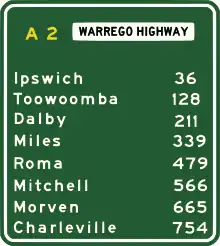

Traffic signs or road signs are signs erected at the side of or above roads to give instructions or provide information to road users. The earliest signs were simple wooden or stone milestones. Later, signs with directional arms were introduced, for example the fingerposts in the United Kingdom and their wooden counterparts in Saxony.
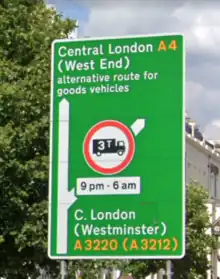
With traffic volumes increasing since the 1930s, many countries have adopted pictorial signs or otherwise simplified and standardized their signs to overcome language barriers, and enhance traffic safety. Such pictorial signs use symbols (often silhouettes) in place of words and are usually based on international protocols. Such signs were first developed in Europe, and have been adopted by most countries to varying degrees.
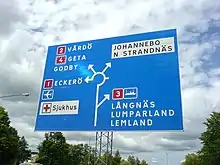
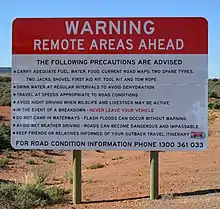
International conventions
International conventions such as Vienna Convention on Road Signs and Signals have helped to achieve a degree of uniformity in traffic signing in various countries.[1] Countries have also unilaterally (to some extent) followed other countries in order to avoid confusion.
Categories
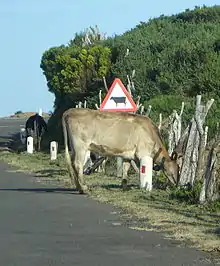
Traffic signs can be grouped into several types. For example, Annexe 1 of the Vienna Convention on Road Signs and Signals (1968), which on 30 June 2004 had 52 signatory countries, defines eight categories of signs:
- A. Danger warning signs
- B. Priority signs
- C. Prohibitory or restrictive signs
- D. Mandatory signs
- E. Special regulation signs
- F. Information, facilities, or service signs
- G. Direction, position, or indication signs
- H. Additional panels

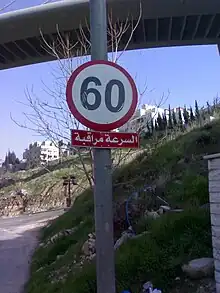
In the United States, Canada, Ireland, Australia, and New Zealand signs are categorized as follows:
- Regulatory signs
- Warning signs
- Guide signs
- Street name signs
- Route marker signs
- Expressway signs
- Freeway signs
- Welcome signs
- Informational signs
- Recreation and cultural interest signs
- Emergency management (civil defense) signs
- Temporary traffic control (construction or work zone) signs
- School signs
- Railroad and light rail signs
- Bicycle signs
In the United States, the categories, placement, and graphic standards for traffic signs and pavement markings are legally defined in the Federal Highway Administration's Manual on Uniform Traffic Control Devices as the standard.
A rather informal distinction among the directional signs is the one between advance directional signs, interchange directional signs, and reassurance signs. Advance directional signs appear at a certain distance from the interchange, giving information for each direction. A number of countries do not give information for the road ahead (so-called "pull-through" signs), and only for the directions left and right. Advance directional signs enable drivers to take precautions for the exit (e.g., switch lanes, double check whether this is the correct exit, slow down). They often do not appear on lesser roads, but are normally posted on expressways and motorways, as drivers would be missing exits without them. While each nation has its own system, the first approach sign for a motorway exit is mostly placed at least 1,000 metres (3,300 ft) from the actual interchange. After that sign, one or two additional advance directional signs typically follow before the actual interchange itself.
History

The earliest road signs were milestones, giving distance or direction; for example, the Romans erected stone columns throughout their empire giving the distance to Rome. According to Strabo, Mauryas erected signboards at distance of 10 stades to mark their roads.[2] In the Middle Ages, multidirectional signs at intersections became common, giving directions to cities and towns.
In 1686, the first known Traffic Regulation Act in Europe was established by King Peter II of Portugal. This act foresaw the placement of priority signs in the narrowest streets of Lisbon, stating which traffic should back up to give way. One of these signs still exists at Salvador street, in the neighborhood of Alfama.
The first modern road signs erected on a wide scale were designed for riders of high or "ordinary" bicycles in the late 1870s and early 1880s. These machines were fast, silent and their nature made them difficult to control, moreover their riders travelled considerable distances and often preferred to tour on unfamiliar roads. For such riders, cycling organizations began to erect signs that warned of potential hazards ahead (particularly steep hills), rather than merely giving distance or directions to places, thereby contributing the sign type that defines "modern" traffic signs.
The development of automobiles encouraged more complex signage systems using more than just text-based notices. One of the first modern-day road sign systems was devised by the Italian Touring Club in 1895. By 1900, a Congress of the International League of Touring Organizations in Paris was considering proposals for standardization of road signage. In 1903 the British government introduced four "national" signs based on shape, but the basic patterns of most traffic signs were set at the 1908 International Road Congress in Paris. In 1909, nine European governments agreed on the use of four pictorial symbols, indicating "bump", "curve", "intersection", and "grade-level railroad crossing". The intensive work on international road signs that took place between 1926 and 1949 eventually led to the development of the European road sign system. Both Britain and the United States developed their own road signage systems, both of which were adopted or modified by many other nations in their respective spheres of influence. The UK adopted a version of the European road signs in 1964 and, over past decades, North American signage began using some symbols and graphics mixed in with English.
In the U.S., the first road signs were erected by the American Automobile Association (AAA). Starting in 1906, regional AAA clubs began paying for and installing wooden signs to help motorists find their way. In 1914, AAA started a cohesive transcontinental signage project, installing more than 4,000 signs in one stretch between Los Angeles and Kansas City alone.[3]
Over the years, change was gradual. Pre-industrial signs were stone or wood, but with the development of Darby's method of smelting iron using coke-painted cast iron became favoured in the late 18th and 19th centuries. Cast iron continued to be used until the mid-20th century, but it was gradually displaced by aluminium or other materials and processes, such as vitreous enamelled and/or pressed malleable iron, or (later) steel. Since 1945 most signs have been made from sheet aluminium with adhesive plastic coatings; these are normally retroreflective for nighttime and low-light visibility. Before the development of reflective plastics, reflectivity was provided by glass reflectors set into the lettering and symbols.
New generations of traffic signs based on electronic displays can also change their text (or, in some countries, symbols) to provide for "intelligent control" linked to automated traffic sensors or remote manual input. In over 20 countries, real-time Traffic Message Channel incident warnings are conveyed directly to vehicle navigation systems using inaudible signals carried via FM radio, 3G cellular data and satellite broadcasts. Finally, cars can pay tolls and trucks pass safety screening checks using video numberplate scanning, or RFID transponders in windshields linked to antennae over the road, in support of on-board signalling, toll collection, and travel time monitoring.
Yet another "medium" for transferring information ordinarily associated with visible signs is RIAS (Remote Infrared Audible Signage), e.g., "talking signs" for print-handicapped (including blind/low-vision/illiterate) people. These are infra-red transmitters serving the same purpose as the usual graphic signs when received by an appropriate device such as a hand-held receiver or one built into a cell phone.
Then, finally, in 1914, the world's first electric traffic signal is put into place on the corner of Euclid Avenue and East 105th Street in Cleveland, Ohio, on August 5.
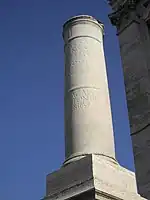 Roman milestone
Roman milestone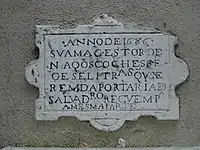 17th century traffic sign in Salvador street, Lisbon, Portugal stating which traffic should back up to give way:
17th century traffic sign in Salvador street, Lisbon, Portugal stating which traffic should back up to give way:
Year of 1686. His Majesty commands all coaches, carriages and litters coming from Salvador's entrance to back up to the same part
Automatic traffic sign recognition
Cars are beginning to feature cameras with automatic traffic sign recognition, beginning 2008 with the Opel Insignia. It mainly recognizes speed limits and no-overtaking areas.[4] It also uses GPS and a database over speed limits, which is useful in the many countries which signpost city speed limits with a city name sign, not a speed limit sign.
Image gallery
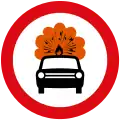 Road sign in Europe: no vehicles carrying explosives
Road sign in Europe: no vehicles carrying explosives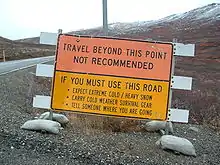 Sign north of Nome, Alaska, providing warning of the road, unpopulated area beyond
Sign north of Nome, Alaska, providing warning of the road, unpopulated area beyond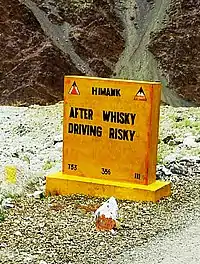 Humorous Himank sign in Lahaul, India
Humorous Himank sign in Lahaul, India Pedestrian crossing sign in Finland
Pedestrian crossing sign in Finland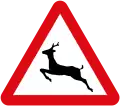 A sign for wild animals. Germany, Poland, Latvia, Spain and Turkey use a very similar sign
A sign for wild animals. Germany, Poland, Latvia, Spain and Turkey use a very similar sign Romantic Road sign in southern Germany (note the Alps in the background)
Romantic Road sign in southern Germany (note the Alps in the background) Pedestrian crossing Slow sign in Buting, Pasig, Philippines
Pedestrian crossing Slow sign in Buting, Pasig, Philippines A Turkish motorway sign
A Turkish motorway sign Sign close to Chicana on the Mexican Federal Highway 186, Campeche, Mexico
Sign close to Chicana on the Mexican Federal Highway 186, Campeche, Mexico The design specifications for a Taiwanese sign warning of double bends ahead. Translated directly, it means that there are winding roads for the next ten kilometres.
The design specifications for a Taiwanese sign warning of double bends ahead. Translated directly, it means that there are winding roads for the next ten kilometres. A group of green-coloured directional signs on the National Highway No. 1 in Kaohsiung, Taiwan
A group of green-coloured directional signs on the National Highway No. 1 in Kaohsiung, Taiwan Stop sign in Australia
Stop sign in Australia_in_Elko%252C_Nevada.JPG.webp) Traffic signal ahead sign in the United States
Traffic signal ahead sign in the United States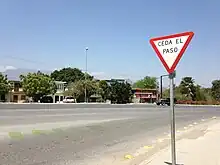 A yield sign in Mexico
A yield sign in Mexico A sign indicating speed limit enforcement ahead in the Czech Republic
A sign indicating speed limit enforcement ahead in the Czech Republic
Rail traffic
Rail traffic has often a lot of differences between countries and often not much similarity with road signs. Rail traffic has professional drivers who have much longer education that what's normal for road driving licenses. Differences between neighboring countries cause problems for cross border traffic and causes need for additional education for drivers.
See also
References
- ↑ Traffic Signs Manual Introduction 1982
- ↑ Prasad, Prakash Charan (1977). Foreign Trade and Commerce in Ancient India. Abhinav Publications. p. 117. ISBN 978-81-7017-053-2.
- ↑ "Where Did the First Road Signs Come From?". Your AAA Network. 2019-12-18. Retrieved 2020-02-21.
- ↑ "Opel Insignia to feature traffic sign recognition system". Archived from the original on 2010-10-26.
External links
Asia
- Pakistani Traffic Rules and Road Signs
- Indian Traffic Rules and Signals
- The Road User's Code: The Language of the Road by the Transport Department of the Government of the Hong Kong SAR
Europe
- Signs and markings British traffic signs from the Highway Code
- Danish traffic signs Archived 2016-12-20 at the Wayback Machine
- securite-routiere.gouv.fr (in French)
- Know Your Traffic Signs - Department for Transport (UK)
- German traffic signs and signals
- Norma 8.,1-IC Style manual for road signs in Spain (in Spanish)
North America
Canada
- Government of Quebec traffic control devices library - Extensive list of all road signs and signals from the Quebec Transport Ministry (in English and French)
- Road Signs in Ontario Archived 2021-07-11 at the Wayback Machine, from the Ontario Ministry of Transportation.
- ICBC – Signs, signals and road markings from ICBC
United States of America
- Federal Highway Administration publications:
- Manual of Traffic Signs – private website based on the MUTCD
- Ensuring That Traffic Signs Are Visible at Night: Federal Regulations Congressional Research Service
- Traffic Signs, An Evolution of Road Signs from 1925 to Present
- 1920’s – a Turning Point in Traffic Sign Design and Sign Shapes
- Road Traffic Signs & Pedestrian Signs - Tips and Articles - Traffic Sign History